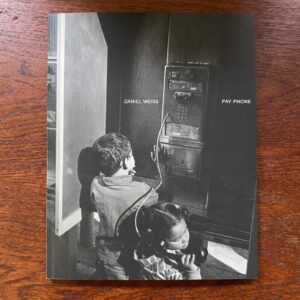JTF (just the facts): Published in 2021 by XYZ Books (here). Hardcover, 21 x 25.5 cm, 56 pages, 29 black-and-white and color reproductions. Includes drawings by Nuno Engstrøm Guimarães, pancake masks by Emma-Sofie Engstrøm Guimarães, and mask sculptures by Sara Bichão. Design by Dayana Lucas. (Cover and spread shots below.)
Comments/Context: Probably every working photographer with young children at home has at some point thought to him or herself that it might be interesting to make more serious photographs of the kids. But engineering the transition from family album-worthy snapshots and one-offs into a robust photographic project is no easy task, and fewer photographers than we’d like to admit have actually done it successfully. In general, such an effort means getting beyond the straightforward documentation of the lives of small ones and instead digging deeper into the psychologies of childhood (and likely at the same time, of parenting).
Since younger children may not fully grasp what photographer mom or dad may be up to, a open sense of collaboration, participation, and trust between art-making parent and child subject is often necessary. This can take the form of playful (or serious) posing, actual improvisation or playacting, or just the seemingly painful repeated request to stand still for a moment longer in the middle of everyday life. While there is no rigid pattern to these kinds of projects (as every family is different), letting the kids direct or arrange the action generally leads to the most surprising and unexpected results.
Rato Tesoura Pistola (or “mouse, scissors, gun” in English) takes this idea of parent-child collaboration in a direction that makes each person an active artistic participant rather than a passive subject. In a very real sense, the Portuguese photographer Pedro Guimarães and his two children Nuno and Emma-Sofie are all artists, with the father making photographs and the two kids contributing not only themselves as subjects, but their own artworks, in the form of crayon drawings and pancake masks. The photobook interleaves all of these efforts together into one integrated flow, and we can clearly see the various artists responding to each other and their work.
The design and construction of Rato Tesoura Pistola place this interaction front and center. Fold out pages printed on both sides place the father’s photographs and the children’s artworks in direct conversation, and the sequencing often finds commonalities and visual echoes that connect the works together. The result is a playful mood, where the page turns deliver call and response visuals which encourage the viewer to see engaged collaboration and influence.
The cover image gets things started with an inversion that sets the tone for the rest of the book. An open mouthed monster raises its arms and legs in an exaggerated moment of spooky fright, the figure constructed from a white bed sheet, two sticks, and some of the father’s photographic lighting equipment. The figure underneath the sheet is actually the father, letting us know that he too will be part of the imaginative play taking place. This image is then matched by a blue crayon drawing of another monster with similar features, setting up the artistic dialogue between family members that gives the photobook its rhythms.
The artist’s son Nuno is a particularly adept monster model, rolling his eyes into the back of his head to look like a white-eyed zombie or snarling with his missing front teeth. Nearby crayon drawings of monsters find obvious parallels with the photographs, via exaggerated eyes and squiggles of mouths. This kind of linking happens again and again throughout the book: between a sheet ghost and dad underneath the dark cloth drapery of his camera; between the eyes of an elaborate painted mask and two holes in a rocky landscape; between kids emerging from the toothy mouth of a SpongeBob bouncy castle and another big eyes toothy smile in a drawing; and cleverly, between the tongue sticking out from underneath a pancake mask and the tongues of a pair of oversized boots.
Eyes (in many forms) are used as a repeated motif. Early in the book, the smiling eyes and skinned knees of a child are matched with the large single eye of a diving monster. Later, a double fold out spread connects eyes through a pancake mask, eyes stitched closed (or with exaggerated eyelashes) surrounded by grasping hands in another mask, a close up red eyeball, an eye peeking through a green leafy jungle, and a wide drawing of curving worms with eyes. And near the end of the book, the empty eyes of a pancake mask against a rough rock face provide a prelude to a surprisingly creepy image of a wide eyed baby with a pacifier surrounded by similarly wide eyed dolls.
Rato Tesoura Pistola ends with an idyllic image of the children lying in the tall grass, delivering an almost perfect vision of playful easy-going childhood freedom. They’ve worked hard in their imaginative play in this photobook, and have earned a satisfying rest. While the artistic efforts (and antics) of the Guimarães family may not be as elaborately constructed or carefully arranged as those of Tim Roda or Sally Mann and their kids, their innocent authenticity is refreshing, and the best of the photographs here lean into that truth to find its surreal edge. A swimming snake in an image on the back endpapers reminds us that some monsters can indeed be real, but in large part, Guimarães and his children have tapped into a stream of contagious joy, even when the imaginary monsters have big eyes and scary teeth.
Collector’s POV: Pedro Guimarães does not appear to have consistent gallery representation at this time. As a result, interested collectors should likely follow up directly with the artist via his website (linked in the sidebar).


















